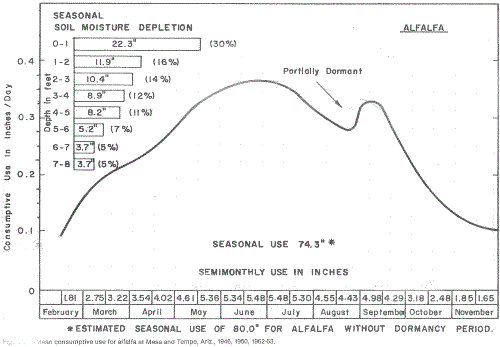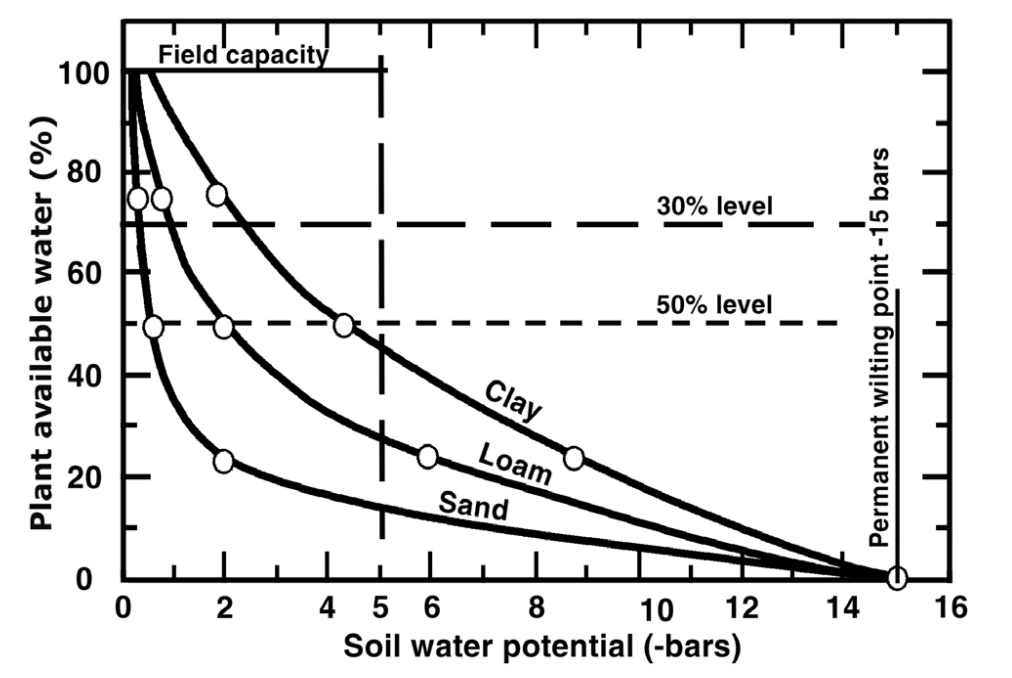

When the soil profile is full of water, reaching what is called field capacity (FC), the profile is said to be at 100% moisture content or at about 0.1 bars of tension. Tension is a measurement of how tightly the soil particles hold onto water molecules in the soil: the tighter the hold, the higher the tension. At FC, with a tension of only 0.1 bars, the water is not being held tightly and it is easy for plants to extract water from the soil. As the water is depleted by the plants, the tension in the soil increases. Figure 1 shows three typical curves for sand, clay and loam soils. As Fig. 1 shows, the plants will use the water in the soil until the moisture level goes to the permanent wilting point (PWP). Once the soil dries down to the PWP, plants can no longer extract water from the soil and the plants die. Although there is still some moisture in the soil below the PWP, this water is held so tightly by the soil particles that it cannot be extracted by the plant roots. The PWP occurs at different moisture levels depending on the plant and soil type. Some plants, which are adapted to arid conditions, can survive with very little moisture in the soil. With most agronomic crops, PWP occurs when the tension in the soil is at 15 bars. This means that the soil is holding on very tightly to the water in its pores. In order for plants to use this water, they must create a suction greater than 15 bars. For most commercial crops, this is not possible. At 15 bars, most plants begin to die. The difference between field capacity and PWP is called the plant available water (PAW).
Irrigation targets are usually set as a percent depletion of the PAW. This depletion level is referred to as Management Allowable Depletion (MAD). The bulk of irrigation research recommends irrigating row crops such as grain or cotton when the MAD approaches 50%. For vegetable crops, the MAD is usually set at 40% or less, because they are more sensitive to water stress. These defined amounts insure that water stress will not be so severe as to cause any appreciable yield losses. Careful monitoring of the PAW needs to be done throughout the season so that the appropriate point of irrigation can be anticipated.
Water may be applied by surface methods or by sprinkler. For surface irrigation, level the soil before planting. A sprinkler irrigation system requires little or no leveling but is more expensive initially than surface methods. Sprinkler irrigation has an advantage where the water supply is limited or expensive, the soil shallow or sandy, or the terrain rough or steep. A sprinkler system is more convenient because it requires less operator time and labor. However, sprinklers are difficult to manage in areas of strong wind. They may require protective barriers to prevent damage by livestock or to prevent injury.
Irrigation amount and frequency will vary depending on weather, soil type, rooting depth and presence of subsoil impervious layers. Most pastures require between 4 and 6 acre-feet per acre of water per growing season. The seasonal water requirement for bermuda grass above 4,000 ft. is 3 to 4 acre-feet of water per growing season. Two or more irrigations should be applied each month during the period of active growth. Less frequent irrigations are required during the late fall, winter, and early spring. The irrigation interval for sands or sandy loam is much shorter than for fine textured (clay) soils.
Soil moisture can be determined by using a soil tube, soil auger, or shovel. Soil moisture should be checked throughout the rooting zone of the species in the pasture. Clover can use moisture down to a depth of about 2 feet, while grasses extract water down to 3 to 4 feet, and alfalfa may extract water down to 6 feet if soil conditions do not impede root growth. Adequate soil moisture should be maintained throughout the entire rooting zone of all plants in the pasture. This requires irrigation often enough to keep the shallow-rooted clovers growing vigorously and deep enough for the grass roots.
Schedule irrigations so that the soil will be firm enough to support livestock, without injury to plants, when the grazing cycle begins. This is especially important to avoid soil compaction. Compacted soils take water slowly, are poorly aerated, and produce less forage. Some compaction will occur on irrigated pastures, particularly when rain occurs during the grazing period. The depth of compaction ranges from 2 to 10 inches depending on the soil type and soil wetness. A good practice is to rip the pasture to a depth of 12 inches every third year.
Certain species of pasture plants can survive with limited water, and plants differ in their water requirement. Warm season grasses utilize water more efficiently during summer months. Cool season grasses such as tall fescue and tall wheatgrass require frequent irrigations during the hot summer months.